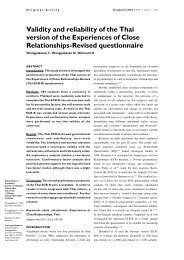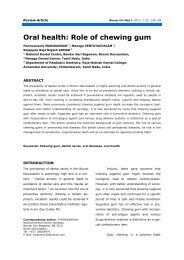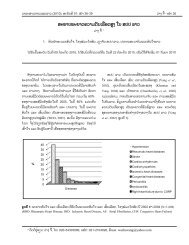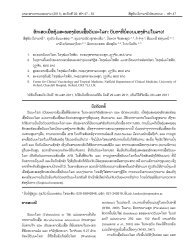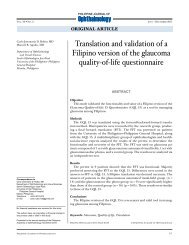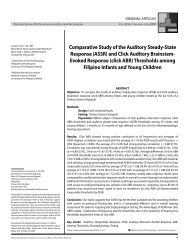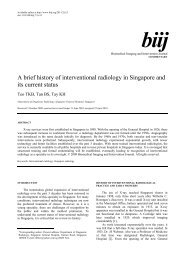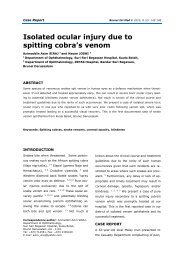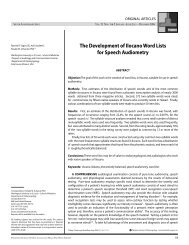You also want an ePaper? Increase the reach of your titles
YUMPU automatically turns print PDFs into web optimized ePapers that Google loves.
Singapore Med J 2011; 52(9) : 676<br />
the fovea in right-sided and left-sided ulnae were<br />
4.5 ± 0.47 mm and 4.9 ± 1.1 mm, respectively (Table I).<br />
20% of both the right- and left-sided ulnae showed an<br />
absence of any vascular formina in the fovea. A previous<br />
study has recorded an absence of any foramina in 24.63%<br />
of the cases involving right-sided ulnae. (9) A substantial<br />
amount of nutrition reaches the TFCC of the wrist from<br />
the synovial fluid of the DRUJ (on the superior surface)<br />
and the wrist joint (on the inferior surface), as well as<br />
from the vasulature in the ligament at the medial end of<br />
the disc by the vascular foramina.<br />
The mean length of the styloid process was<br />
5.2 ± 0.82 mm and 5.0 ± 0.67 mm on the right- and leftsided<br />
ulnae, respectively (Table I). If the length of the<br />
styloid process was > 6 mm, it was considered a criterion<br />
of long ulnar styloid process. (10) The length of the styloid<br />
process may act as a causative factor in ulnar styloid<br />
triquetral impaction, causing ulnar-sided wrist pain. (11) The<br />
dorsal surface on the head of the ulna showed a groove<br />
for ECU tendon in all left-sided ulnae and in 80% of<br />
right-sided ulnae (Table II). Its anatomical position is of<br />
great importance in the treatment of dislocation of the<br />
DRUJ.<br />
Over the last decade, there has been a greater<br />
appreciation of the anatomy and mechanics of the<br />
proximal radioulnar joint compared to the DRUJ.<br />
Morphometrical analysis of the DRUJ is still evolving.<br />
Traumatic derangements around the ulnar head<br />
usually affect the DRUJ. Most untreated injuries to<br />
the bony or stabilising ligamentous structures lead to<br />
arthrosis of the DRUJ. Therefore, the aim must be to<br />
restore normal anatomy in an acute situation, whenever<br />
possible, rather than delaying it until only excision<br />
or arthrodesis remains the treatment of choice. Also,<br />
in certain isolated intra-articular fractures of the<br />
head of ulna, open reduction and internal fixation<br />
with K-wires, screws or small plates is a common<br />
treatment. In all these cases, if the congruency of the<br />
joint is not restored, permanent functional impairment<br />
will ensue. (8) The dislocations of the ulnar head with<br />
concomitant fracture of the radius (Galeazzi lesion)<br />
had been treated by implantation of prosthesis such<br />
as the Herbert Ulnar Head instead of arthrodesis, as<br />
commonly found in the literature. (7) These metrical<br />
values of structural anatomy of the lower end of the<br />
ulna are valuable for reconstruction of the DRUJ with<br />
prosthesis. While the literature is replete with detailed<br />
anatomical descriptions of the distal end of the radius,<br />
the lower end of the ulna is a neglected area of research<br />
in the Indian population. Therefore, our study aimed at<br />
providing the morphometric database for configurations<br />
and kinematics of the distal end of the ulna, which is a<br />
less frequently researched area in the Indian context.<br />
REFERENCES<br />
1. Oatis CA. Kinesiology in structure and function of the bones<br />
and joints of the wrist and hand. 2nd Ed. The Mechanics and<br />
Pathomechanics of Human Movement. Baltimore: Williams and<br />
Wilkins, Lippincott, 2003:243-54.<br />
2. af Ekenstam F. Anatomy of the distal radioulnar joint. Clin Orthop<br />
Relat Res 1992; 275:14-8.<br />
3. Almquist EE. Evolution of the distal radioulnar joint. Clin Orthop<br />
Relat Res 1992; 275:5-13.<br />
4. King GJ, McMurtry RY, Rubenstein JD, Gertzbein SD.<br />
Kinematics of the distal radioulnar joint. J Hand Surg Am 1986;<br />
11:798-804.<br />
5. Tulley E. Sports physiotherapy applied science and practice in<br />
the wrist and hand. 1st Ed. Sports Physiotherapy Melbourne:<br />
Churchill Livingstone, 1995: 439-42.<br />
6. Spinner M, Kaplan EB. Extensor carpi ulnaris. Its relationship to<br />
the stability of the distal radio-ulnar joint. Clin Orthop Relat Res;<br />
1970; 68:124-9.<br />
7. Grechenig W, Peicha G, Fellinger M. Primary ulnar head<br />
prosthesis for the treatment of an irreparable ulnar head fracture<br />
dislocation. J Hand Surg Br 2001; 26:269-71.<br />
8. Berger RA, Weiss APC. Hand Surgery vol 1. 1st Ed. Philadelphia<br />
USA: Williams and Wilkins: Lippincott 2004: 297.<br />
9. Joshi SD, Joshi SS, Athavale SA, Kishve PS, Jadhav SD. Metrical<br />
and non-metrical study of lower end of ulna. J Anat Soc India<br />
2009; 58:156-60.<br />
10. van Der Heijden B, Groot S, Schuurman AH. Evaluation of ulnar<br />
styloid length. J Hand Surg Am 2005; 30:954-9.<br />
11. Giachino AA, Mclntyre AI, Guy KJ, Conway AF. Ulnar styloid<br />
triquetral impaction. Hand Surg 2007; 12:123-34.




